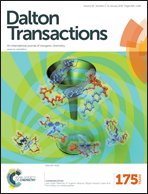Highly functionalizable penta-coordinate iron hydrogen production catalysts with low overpotentials†
Abstract
Penta-coordinate iron carbonyl complexes that are built around the rigid Fe(PNP) motif (PNP = (C6H5)2PN(R)P(C6H5)2) are synthesized and structurally and spectroscopically characterized. These complexes allow for facile customization of the secondary ligand sphere with various types of linkers and functional groups. The new [Fe(S2C6H4)(PNP)(CO)] complexes show dihydrogen production electrocatalysis at overpotentials of 0.09–0.21 V vs. Pt under mildly acidic conditions (and activities from 0.28 to 3.51 s−1). The most active compound exhibits a turnover frequency (TOF) of 3.51 s−1 at an overpotential of only 0.15 V vs. Pt. Trends in activity are further analyzed. It is found that (a) a decrease in overpotential correlates strongly with the electron withdrawing strength of the PNP amine substituent, and (b) aliphatic substituents give comparatively higher TOFs than aromatic ones. An EC-type mechanism is shown to proceed by initial reduction of the FeII metal center and proposed formation of an FeIII hydride intermediate. Analogous cobalt compounds were synthesized and characterized, but were found to have low stability in acidic media under turnover conditions, and hence, are unsuitable as catalysts for proton reduction.


 Please wait while we load your content...
Please wait while we load your content...